Water is a commodity that we tend to take for granted when living off a municipal source.
Once we take the plunge into going off grid, it becomes the primary concern.
Where will the water come from? How will we get the water from source to home? How will we filter and purify the water?
Although the internet is packed with information, I have found that there is only a patchwork of pieced information that isn’t very substantial to designing an independent water system.
I have written a series of articles that helps pull all the pieces together so you can make the best design for your off grid system.
In this article, I delve into the various types of off grid water pumps that you can utilize to setup an off grid water system.
If just starting on your off grid water system journey, I suggest reading my Off Grid Water System Guide which covers the different types of water sources and how to get that water to your home.
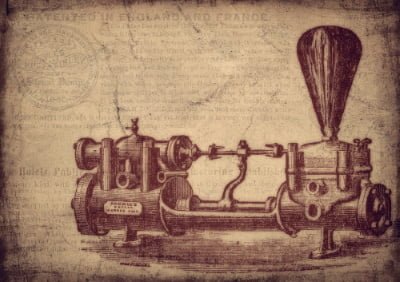
The Different Types Off Grid Water Pump Systems
The type of pump you choose for your system will depend on what type of water source you are drawing from.
Off Grid Well Pumps
Wells are often the best choice for water on a homestead. Wells are rather expensive but can last for several decades and can withstand through winters and times of drought.
Wells are usually installed by a professional. You can try to dig a shallow well like they did in the old days, but its an excruciating amount of work and is quite dangerous. Shallow wells have a higher chance of being contaminated, so make sure to filter and purify your water correctly.
You can read all about off grid water filtration and purification in my guide.
1. Shallow Well Jet Pump
A shallow well jet pump is not placed directly into the well, rather it is placed above the well and pulls the water up from the well using suction. This suction creates a vacuum that automatically pulls the water up much like how a straw does. Once the suction is made, the atmospheric pressure pushes the water up and becomes an autonomous system.
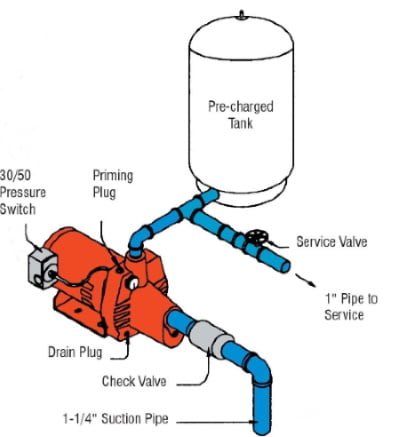
A shallow well jet pump is just for that – shallow wells. It is limited to how high it can lift the water in relation to the pressure of the air. Therefore the depth maximum is usually 25 feet. These pumps also require to be primed with water to work. A foot valve is optional but is a typical component on shallow pumps to avoid water from backing out.
2. Deep Well Jet Pump
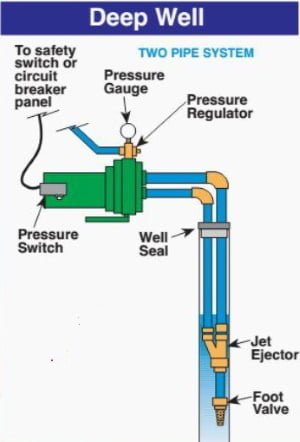
The deep well version of the jet pump is similar to the shallow pump setup. The pump sits above the well and works in the same way as the shallow version. However, the ejector component is separated from the pump and is placed deep into the well to push the water up to the pump.
A deep well jet pump can be used for a depth of around 200 feet (depending on altitude) yet can be accessed easily if it ever needs servicing. A foot valve is used at the bottom of the well pipe so water does not drain back out. The deep well jet pump also needs to be primed before use.
3. Convertible Jet Well Pump
A convertible jet well pump is a deep well pump that can be altered for both shallow and deep wells.
An ejector assembly is used to convert the pump from shallow to deep. You can use a convertible pump for pulling water from streams, lakes, and rivers; you can then convert it into a deep well pump for depths over 25 feet.
This could be a good solution if you are using a temporary water source before installing a deep well. This will save you the cost of having to purchase a new pump down the road.
A Note on Jet Pump Systems
Due to the nature of pulling water as opposed to pushing water, above-ground pumps tend to have a higher rate of breakdowns and failures.
If the pump loses its prime, it will cause the motor to burn out. This is why many well owners choose the submersible pump.
4. Deep well submersible pump

This type of centrifugal pump is lowered all the way into the well and pushes the water instead of pulling it up. This pump fits into the well casing and is connected to an above-ground power source with wires.
The motor is sealed to prevent water from short-circuiting the pump. A submersible pump must always be submerged in water in order for it to work.
The submersible well pump needs to be sized in accordance with the peak needs of your water usage and the water yield of the well. Never go beyond pumping more than what your well can produce unless you have a storage of water to supplement it.
Submersible pumps have a long shelf life; you can expect your pump to last up to 25 years. They typically have fewer problems than above-ground pumps and will last as long as they are fully submerged in water.
If the pump does break, it will have to be pulled out of the well to be serviced, which usually calls for a professional.
5. Hand Pump Well System
Having a manual hand well pump system on your property isn’t a bad idea for a backup water source. A hand pump requires no electricity and are extremely reliable.
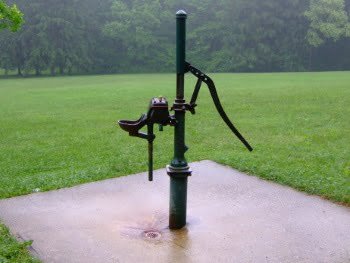
A hand pump system has very few parts; a cylinder that is placed within the dug well, a piston, two valves, water, and air.
When the lever is pushed down, the piston goes below the spout level which shuts off airflow. The lower valve then opens which draws the water up into the cylinder.
When the lever is pulled up, the lower valve closes which traps the water in the cylinder, and airflow is opened which raises the water up more.
The pushing and pulling of the lever raises the water until the water comes gushing out of the spout.
There has been a trend of installing antique water pumps, so the demand for these pumps has risen. You can find authentic ones on eBay or purchase a replica.
A hand well pump probably won’t be your primary source of water but could be a nice supplement for filling water troughs and watering the garden.
Off grid pumps for lakes, rivers, and streams
When pumping from a natural source of water on your property, you need to consider the distance the water has to travel and the rise from the water source to the destination.
Now, if your water source is uphill from the destination, you are in luck. You may be able to use gravity in replacement of a pump!
For the rest of us, we need to choose a correct off grid water pump that will work for pushing water from a downhill water source without burning up the pump.

1. Shallow Well Jet Pump
Jet pumps are very powerful as they are used to vertically lift water out of a well.
These pumps work great for sucking water from a downhill water source and can be used to push water on a slope for a good distance.
You can dig a makeshift well right next to a water source and place the shallow well jet pump on a platform next to the sump hole. Then lower in the attached piping into the hole.

Make sure to use some sort of filtration screen enclosure at the end of the submerged piping so it doesn’t get clogged with debris.
Note that jet pumps are installed on dry ground and need to be primed before use.
2. Submersible Sump Pump
A submersible sump pump is a great option for pumping water from the wild into your water system.
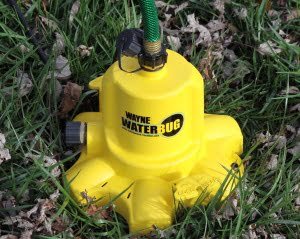
Since sump pumps work by pushing water instead of pulling, you can get a decent amount of pressure to make it up an incline.
When you purchase a submersible sump pump, make sure to check the gallons per minute by feet of head, as the deeper the pump is lowered into the water, the less GPM you will get.
Dig a sump hole next to a water source and line with large rocks, then lower in your submersible sump pump. Make sure to build a screen enclosure to filter out debris.

A submersible pump is a nice option as you can easily relocate the pump to different areas of the water source, a good feature if your water source changes depth and shape.
Make sure to add a filter around the pump so you are not sucking up debris into your piping.
I have written an extensive guide on the Best Submersible Sump Pumps to help you make an informative and smart purchase decision.
3. Marine Bilge Pump
A marine bilge pump may not be the first kind of pump you would think of for this task, but they are extremely powerful and durable for outdoor applications. They are also very reliable.
A bilge pump is designed to pump large amounts of water very quickly as they are used to get water out of a (sinking) boat!

Bilge pumps can pump out a tremendous amount of water to the tune of thousands of gallons per hour, however, they are designed for very little head (the rise of the water) so pumping uphill with a bilge pump will be less effective.
You can expect a bilge pump to handle 0 – 25 feet of rise depending on the model.
This pump could be good for moving massive amounts of water from one location to another. A possible use case is if you need to get your water from a far location to a holding sump pit near your destination.
Special Note on Pumping Wild Water
do not use a garden hose for your suction line as it will likely flatten out and stop the flow.
The diameter of a garden hose will not be big enough and can stifle the output of the pump. Go with at least 1” PVC pipe or specially designed suction hose.
Make sure the water is filtered of large debris before sucking it through your pipe system. This can be done with a homemade screen filter or a prefabricated one.
Pumps for water storage tanks
A water storage tank can come in various shapes, sizes, and depths, and types. There are tanks for hauling water, underground cistern tanks, and rainwater collection barrel tanks.
A cistern water system is a good choice for properties that do not have enough water production year-round but have enough water for partial support.
The tank can hold any excess water from the source be it a low producing well or seasonal stream. If water needs cannot be met, then additional water can be hauled in and stored in the cistern.

There are pumps specially designed to pump water from cisterns to the desired destination.
1. Cistern submersible pump

This pump is specially designed for a cistern and is lowered all the way to the bottom.
The pump is designed to suck in water from the bottom side of the pump so the cistern can be almost completely emptied, although an underground cistern should not be emptied entirely.
The pump does not need any casing and can be dropped in as-is.
2. Shallow well cistern pump
A shallow well jet pump works as a great option for pumping water out of a cistern.
Note that the elevation of the pump and the inlet pipe running to the pump should be very similar in elevation.
If there are any high spots between the cistern and the pump, it can cause an air bubble that prevents flow.
The pump can be installed at a lower elevation than the cistern.
Information about Cistern Pumps
You will need to install additional components when using a cistern as your main water source. A check valve, pressure switch, and water pressure tank, respectively.
A check valve allows the water to flow in one direction and keeps the water from backflowing into the system. If there is no pressure switch on your pump, then the check valve needs to be installed between the cistern and the pressure tank, typically at the outlet of the cistern. If there is a pressure switch on the pump, then install the check valve at the inlet of the pump.
The pressure switch turns your water pump on or off when it reaches certain pressures. The pump is turned on at around 20 – 30 PSI and is turned off at 40 – 50 PSI. Many pumps have a pressure switch installed on the unit.

A water pressure tank does just that, provides pressure to the water. A pressure tank works by creating water pressure from compressed air that bears down on the water. When the valve gets opened, the water is forcefully pushed from that air in the tank. Once the pressure drops to a certain low, the tank’s water pump turns on and more water fills the tank; this is the cycle of the pressure water tank.
You can check out my pressure tank sizing instruction in my guide to building an off grid water system.
Go Pumpless! Off Grid Gravity Water System
Harness the law of gravity and eliminate your need for a pump! If your water source is located uphill from your water destination, or if you have a nice hill that you can place your water tanks, then you may be able to remove your need for a pump entirely.

There is a simple equation for figuring out how much pressure you get from elevation. Each foot of elevation change amounts to .433 PSI of water pressure. The typical pressure for home usage is around 40 – 45 PSI. Therefore, 100 feet of elevation (or feet of head) will provide tons of pressure for a homestead without the use of a pump.
100 feet seems like a lot but carried out over a slope or hill, the elevation can add up fast.
Note that this calculation is based upon static pressure of water, such as still water from a tank or a deep water hole. If the water is flowing, this creates dynamic pressure and the system would actually lose pressure due to friction on the sides of the pipe.
I hope you have found my off grid water pump guide to be informative and helpful.
Have you built or are planning to build an off grid water system with pumps or gravity? Share your thoughts below!


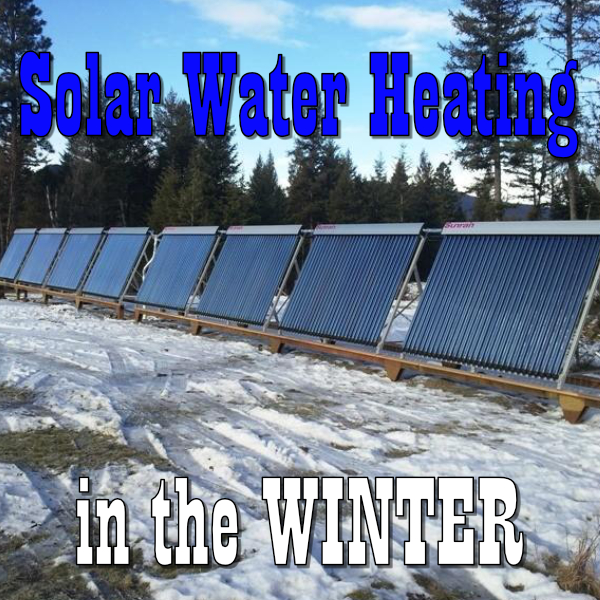
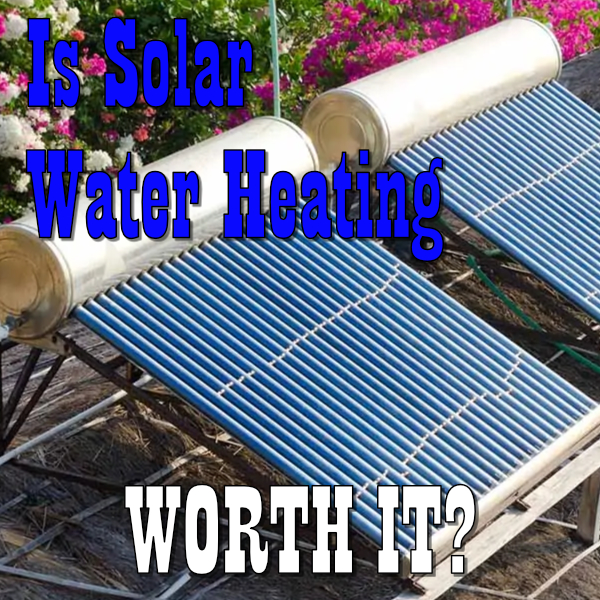
I’m looking at installing a rain water collection system to a cabin I have that is considered off grid , plan on putting in at least 6 ,55 gallon drums any recommendations for a pump ? I have a small one now that I use for
fresh water, I take 15 gallon drums out there to use . Thanks
It really depends on your water usage. Shower, sink, toilet? Watering a garden? Outside water usage?
You will also need to consider the pressure as well. Pulling water with a pump will not give you adequate pressure for home plumbing use.
Will the barrels be connected? If not, a single rain barrel will be depleted within minutes of turning on a pump.
Will you pump the water from the rain barrels into a cistern tank? That would be my recommendation if you are wanting to set up a fulltime off grid water system. Then you use a cistern pump and a pressure water tank.
So many questions . . . 😉
Regina,
I have a shallow well on a piece of property i am buying. it is 1-1undefined4 and is 45 foot deep. I put a pitch pump on it and it would not work as they only go up to 25' deep. what size pump would i put on this pipe to suck the water up?
Hello Paul! I recommend a deep well submersible pump. Here is a good one at a decent price: https://amzn.to/2EHvEkb it can drop to over 200′ of head. Of course, do your own research to make sure it is the right horsepower and gpm for your water needs. Cheers!
I just purchased some property that has a well pump that plugs into a generator. The old owner had a holding tank above well and used gravity feed. I plan on putting my rv there for weekend/vacation use. I feel like I should be able to eliminate the holding tank, power the well pump connected to a pressure tank and connect to rv. How can I power this without the generator and do you think my idea would work? Thank you
Does the RV have a generator? Are you planning on putting a permanent power solution there? You can plug it into the RV if it has its own generator. You can put solar on the RV and run it that way too as long as it could provide enough power. Or you can setup a solar power system specifically for the pump and pressure tank, which will require an inverter. I don’t see any issues with your setup, I think its a good idea. You also need to consider the voltage and wattage of the pump as well.
hello, are you still answering questions on this subject?
thank you, Brad
Yes, it has been a while since I have attended to my comments, but I am here now. What’s up?
Hi! Thanks for all your info. We are living in an off grid cabin with rain catchement. (We chose to do solar power BUT I gave up on water after about 6 months of buearacracy with the local utility). We are getting enough rain and can have water delivered if we need to. We had 5 (FIVE) 55-gal drums plumbed to catch from the roof and then go into the house with an external pump, but they started leaking. Then the pump failed, and the replacement failed. Then we switched to a marine pump, but that failed too. All had built in pressure switches, but I don’t think we ever had a “check valve”. We had a 275 gal ibc tote in back up, but now it’s our primary to use while we attempt to re-plumb the barrels. The IBC is a stand alone, and we’re hauling buckets till we get a new pump.
I want to connect the IBC to the 5 barrels we have, once we get them re-plumbed. (Thank you for mentioning that garden hoses won’t handle the suction from a pump!!! I was thinking about trying them!)
????? Is it feasible to hook up the 5 barrels to the IBC? Does it matter if the water goes into the ibc then overflows into the barrels? Or vice-verse?
????????? Can we put a submersible pump inside the IBC when it’s hooked up with the other 5 barrels?
We did have some algae in the IBC and used bleach (1 cup in about 70 gallons of water) to kill it and rinse it out. That was about two weeks ago. I still have to figure out how to paint it or cover it with tarp so the algae doesn’t come back.
???????? if there’s any trace of algae in it, will it harm a pump?
I hope this is the right amount of info. I’m kind of overwhelmed every time I think about it. Thank you so much for your time and thought.
Hi Tori! Off grid water systems can be stressful. Is there any possible way to use gravity instead of water pumps for your off grid system? I have an IBC tank lifted about three feet off the ground and I am getting pretty good pressure. Another couple of feet would be perfect for my water needs.
If not, then I don’t see any reason that your setup wouldn’t work, as long as your plumbing is done right, the barrels can be hooked up to IBC and vice versa. Then throw a submersible pump in there and you should be golden. Just make sure your pump is always underwater so it doesn’t burn out.
Have typical 200 ft well w pressure tank in Augusta GA. 4in PVC 1/2hp 10gal min 40-60,psi.
Want, tank at surface 200gal… Water pumped up under pressure of gravity and modified pool sand (charcoal and sand filter only… Water directed to storage, float switch stops / starts pump flow.
Then hooked to some type of pump at surface drawing off of tank when faucets are opened and system senses drop in pressure.
Why? Competing with city water option that brings in very good volume of water at 75psi plus. Tired of paying nearly $100mo for water connected to and part of sewer bill Argh
If you know if a system like this I would love to hear if it. Tks
Hi Greg! So if I am reading this correctly, you already have the well installed? Or you are wanting to install a well to eliminate your water bill?
As long as you have the proper well equipment with the right size pressure tank, you should have no problem.
Could also filter if necessary in the other side of the pump otw to the home too.
If your well water is good, you may not even need to filter it. If you do, there are some whole house sediment filters available that work really well. https://amzn.to/3nXyBnu